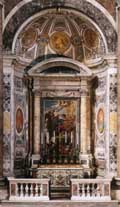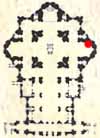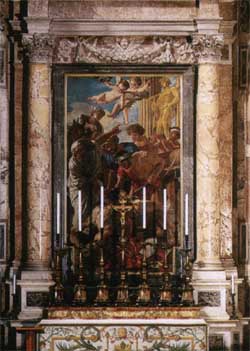| Grottoes
Vatican City Colonnade Saints Floorplan #2 |
| Altars
Monuments The History |
| Related
Sites St. Erasmus |
|
In the north transept, the first altar on the left is that of St. Erasmus, with the altarpiece copied from a painting by Nicholas Poussin. The original was taken to Paris under Napoleon, but was later returned, and is today in the Vatican Pinacoteca.
|
 |
From:
'St. Peter's Basilica - A Virtual Tour'
by Our
Sunday Visitor
The left hand altar is dedicated to St. Erasmus, a martyr at Formiae under
Diocletian, whose worship was instituted in St. Peter's by Gelasius II
in 1118. The altarpiece was transformed to mosaic in 1739 by Cristofari
and Ottaviani, very faithfully reproducing the colors and the lines of
the original painting by Poussin, donated to the Basilica by Cardinal
Francesco Barberini and now in the Vatican Pinacoteca.
It is a work of emphatic grandeur, much admired at the time of its painting, but marred by a stylistic and interpretative compromise of this master of 17th century classicism, who in this example shows himself open to the Caravaggesque influence in the crude representation of the martyrdom, and some Baroque inspiration in the young angels.
''The Altars and
Altarpieces of New St. Peter's' by Louise Rice, ©1997, Cambridge
University Press pp. 225-9
Like the other transept chapels, it was sumptuously decorated with polychrome
marble revetment and gilt stucco under Clement VIII, as part of the pope's
larger scheme to embellish the tomb of the Apostles and its surroundings.
In 1606, under Paul V, the altar was provided with the relics formerly
in the altar of St. Erasmus in old St. Peter's ... it was consecrated
accordingly in October 1628.
The cult of St. Erasmus, bishop of Antioch martyred under the Emperor Diocletian, was introduced in St. Peter's in 1119 by Pope Gelasius II. An altar in honor of the saint was located against the inner facade between the Porta Romana and the porta santa. The Erasmus altar in old St. Peter's was not particularly important liturgically, having no endowment and no chaplaincies associated with it. On the other hand, it seems to have been exceptionally popular with the faithful, who flocked to it and covered it with votive offerings or various kinds, and it was probably due to this that the title was perpetuated in the new basilica.
This was the painting, (earlier work of unknown artist) then that stood over the altar of St. Erasmus in new St. Peter's from around 1605 until around 1629. It was old-fashioned, it was in poor condition, and furthermore its squarish shape did not conform to the vertical dimensions of the altar frame ...the old altarpiece clearly had to be replaced.
At this point Francesco Barberini introduced another his protégés, a little-known Frenchman called Nicolas Poussin, and made it clear that he wanted the commission to go to him.
Poussin was instructed to paint the saint's martyrdom. He pictured the saint as a heroic nude, muscular and athletic, bent backwards over a rough wooden bench, his arms bound above his head. His bishop's miter lies discarded on the ground, and his gorgeous red vestments are spread out beneath him like a pool of blood. Above him, the pagan priest, dressed in white, points urgently toward a gilded bronze statue of Hercules in the upper right corner, as though expecting the saint, even in extremity, to change his mind and worship the idol. The executioners, four in all, go about their grisly business, pulling out the saint's intestines and winding them on a spool. Their turbans provide a note of exoticism, evoking the lands of the Middle East where Erasmus preached and died.
Poussin's St. Erasmus is a compelling and complex work of art, in which a brutal subject is made beautiful. It is probably the best known of the altarpieces in St. Peter's and, despite its goriness, one of the best loved. It is difficult to understand, therefore, why it is often asserted that the painting was considered a failure. Indeed, some scholars have maintained that the critical reaction was so unfavorable that it resulted in Poussin's abandoning large-scale religious art altogether.
Gianlorenzo Bernini, for one, admired the work tremendously. It demonstrated, he said, "a profundity and solidity of knowledge," and were he himself a painter, "this work would make him deeply envious."
Bernini claimed to
have observed Poussin while he was painting the Erasmus, and implied that
the Frenchman made use of a light palette in order to compensate in advance
for the darkening effects of aging.
The evidence suggests that, at the time of its unveiling, Poussin's Martyrdom of St. Erasmus was highly regarded.
The altarpiece remained
in situ until 1739, when it was replaced by a mosaic reproduction by Pietro
Paolo Cristofari. Along with Guercino's St. Petronilla and Sachi's Miraculous
Mass of St. Gregory, it was taken to Paris under Napoleon, but was later
returned, and is today in the Vatican Pinacoteca.


